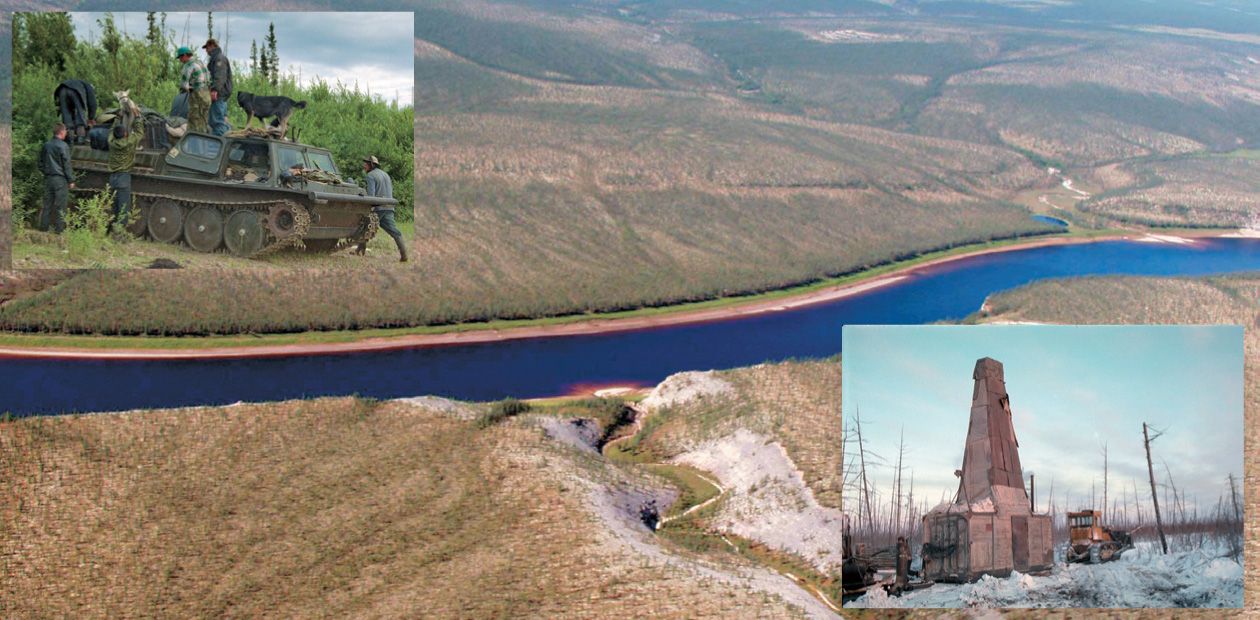The Route to Tomtor. History of Exploration
The history of the discovery of the Tomtor rare-earth Klondike in northern Yakutia is long and complicated. Over fifty years had elapsed since the first findings of alkali rock fragments till the discovery of overwhelmingly high concentrations of niobium and other rare elements in the course of methodical exploration of the giant massif of alkali rocks
The history of the discovery of the Tomtor rare-earth Klondike in northern Yakutia is long and complicated. Over fifty years had elapsed since the first findings of alkali rock fragments till the discovery of overwhelmingly high concentrations of niobium and other rare elements in the course of methodical exploration of the giant massif of alkali rocks
The entire history of Tomtor exploration fills the time span between two photos. One depicts me radioing the finding of a large body of ultramafic–alkali rocks, named Tomtor. The other shows taiga dissected by corridors along drilling profiles, where drilling equipment is ready for operation.
The prospecting revealed a rare-metal deposit, commensurable with those richest in the world. The richness of but one sector, named Burannyi, is described in A.V. Tolstov’s article published in this issue.
Name
As the legend implies, the presence of abundant angular fragments of ultramafic–alkali rocks in the Tomtor region had been known for long before our work. This is not true. Actually, Sergei Gulin was the first who found such fragments in 1958.
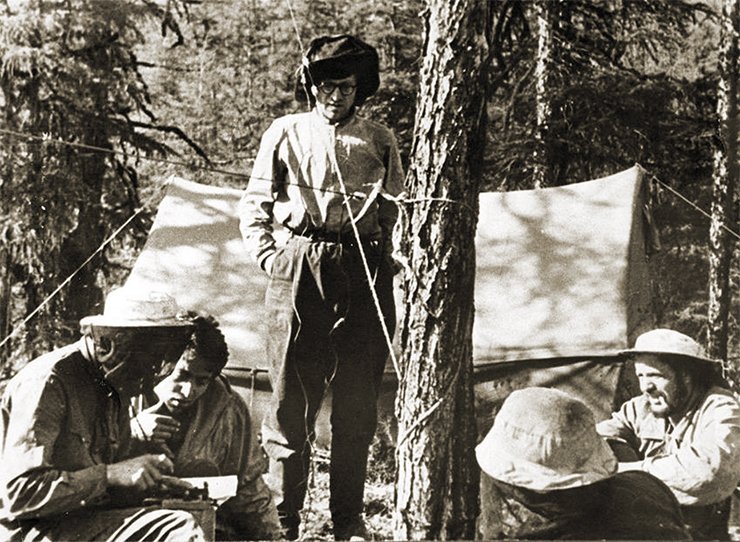
Gulin and I became friends in our first year at the Mining Institute. We went together to a field trip to Soviet Central Asia. We were inseparable in the last two or three years of our studentship, up to being blamed for the absence of team spirit. Sergei was medium-sized, strongly built, chubby-faced, and dark-haired. He had a sharp tongue and was quickly responsive to everything. Being lively and festive, he looked more adult than any of us. Even in studentship, he loved women, being overpowering for them. He was fond of extreme sports: alpine skiing and motorcycle racing. He had an eagle eye, and his observations were accurate; he did not confine himself to describing facts but comprehensively analyzed them. It happened that some critical events in my life after graduating the Mining Institute were closely associated with Gulin.
The head of our expedition E.Ya. Radin showed samples taken by Sergei to other team leaders and asked: “What is this?” For me, a trainee of the Leningrad geological school, the answer was obvious: These are rocks typical of the Khibiny massif, Kola Peninsula. They were later named rischorrites after the locality of their discovery, Mt. Rischorr. Gulin found them in Lower Jurassic conglomerates, and considered the conglomerates themselves the source of alkali rocks.
No major bodies of alkali rocks were found in the region that time. Gulin described only small dikes and sills of altered ultramafic rocks and one exposure of nepheline syenites near the Ongkuchakh River. He also discovered the Udzha anticline and a rich rare-metal deposit within it. Gulin left us the discovery of Tomtor, because he had to go to Chukotka for family reasons in 1959.
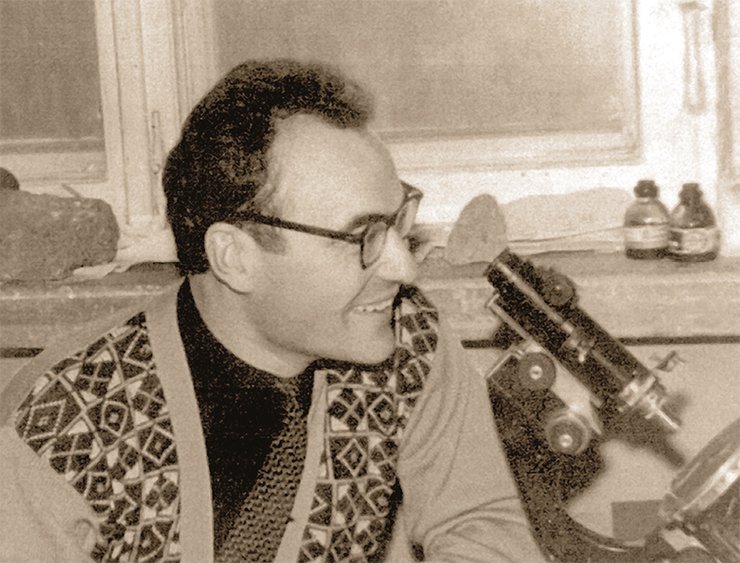
Nepheline syenite bodies were discovered a year later, in the course of geological survey at 1 : 200,000 scale. We started our routes immediately after snow thawing, and daily reports of geological observations revealed fragments of Khibiny-type rocks. To avoid missing significant details, we set the traverse net across the presumed axis of the igneous body built by the rocks. Comprehensive study of the topography of the site showed that only there low ridges of flat hills formed a series of arcs closing at the point named Tomtor-Taasa, which means stony hill in Yakutian.
The arcs got our attention. Most of known massifs similar to Kola Khibiny and Lovozero form circular assemblages of arc-like bodies. For this reason, we adopted the working hypothesis of the circular shape of the massif we named Tomtor. This idea appeared reasonable to all of us.
Years later, I was astonished to see that a borehole drilled close to the center of the massif, near Lake Borongko, penetrated Upper Riphean dolomites where nepheline syenites were expected. One cannot ignore facts, and we had to compile an abnormally cut model instead of a regular circular one. One year still later, our tractor broke down, and the drilling rig stuck down farther west of Borongko. The classical command was given: Drill where you are. We were glad to find out that the drilling results amply proved the circular structure. The dolomites of the previous borehole appeared to be associated with a large inclusion of roof rocks in intrusion rocks of the massif.
With all these circumstances, S.M. Kravchenko statement (Kravchenko and Belyakov, 1992) that it was he who had discovered Tomtor and predicted there a rich niobium deposit is ridiculous and ugly. He saw his trip as a heroic deed when told about the horrible remoteness of the site.
As if that were not enough, when Alexander Tolstov and his colleagues conducted drilling and prospecting works in Tomtor, Kravchenko published an article on its ore content in the high-class American journal Economic Geology. Later, Alexander and I submitted a paper on our results to the same journal, and the reply was that the journal published only original information. Maybe, theft is a too strong word, but that man obviously had no idea of morals.
Independence war
After the first step of prospecting, the study of Tomtor was suspended for long. The exploration resumed many years later, in 1973. The assessment of ore reserves depended on two factors.
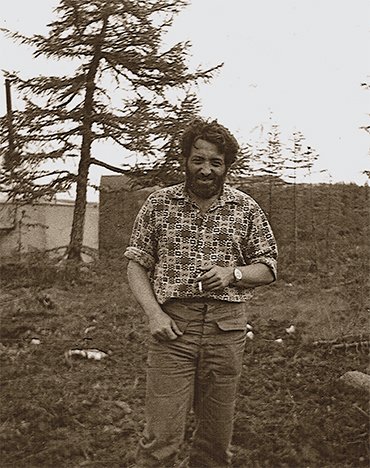 The first factor was size. If Tomtor was similar to Khibiny in composition, then it was the third largest massif of the type next to Khibiny themselves and Lovozero. Consequently, ore reserves might be expected to be roughly the same.
The first factor was size. If Tomtor was similar to Khibiny in composition, then it was the third largest massif of the type next to Khibiny themselves and Lovozero. Consequently, ore reserves might be expected to be roughly the same.
The second factor was the type of nepheline syenites. Why did we mention the similarity to Khibiny? The Kotui–Maimecha province of ultramafic–alkali rocks is located relatively close, west of the Anabar Shield. This prompted some researches to regard Tomtor as its component. However, the nepheline syenites of the said province belong to the miaskite type, whereas those of Khibiny and Lovozero are typically agpaitic. It is also important that massifs of Khibiny type always show rich mineralization, in contrast to Kotui–Maimecha ones, formed later. The main opponent in this problem was L.S. Egorov, the most prominent expert at the Institute of Arctic Geology, who had explored the Kotui–Maimecha province. He believed that Tomtor was its part, whose structure and origin were similar to massifs occurring there. Specific features of the Udzha province are considered in my article in Zapiski VMO (Erlikh, 1964).
Strictly speaking, Egorov’s arguments against our concept were reasonable. Indeed, Khibiny rocks are characterized by elevated zirconium contents, not found in Tomtor. In defending the uniqueness of Tomtor, I referred to our single K/Ar radioisotopic date of phlogopite. It was 200 Ma older than Kotui–Maimecha rocks. Egorov pointed to the poor reliability of occasional tests. In reply to the unusually large size of the massif in the consideration of its origin, he just lifted his hands, “This is not an argument.”
Nevertheless, in spite of his objections, Egorov included Porshnev and Stepanov’s article (1980) to the collection he edited. Later, he published another work dedicated to the Udzha province, where he and Stepanov were co-authors (Egorov et al., 1985).
The abnormal situation was not our fault. Rather it stemmed from the abnormal relationships between research and industry. The head of the production crew L.L. Stepanov dreamed of being blessed by a great scientist (and Egorov was such), whereas Egorov liked the role of supervisor of the Udzha project (although he was not). As mentioned by Stepanov (2002), Leonid Egorov acted as a patron when congratulated us on Tomtor discovery. As a result, he positioned himself in line with Kravchenko. In all debates, vanity overpowered researcher’s integrity.
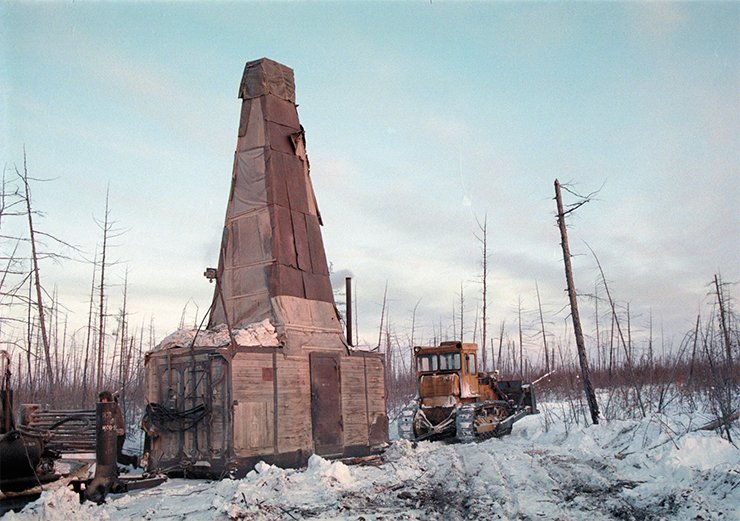
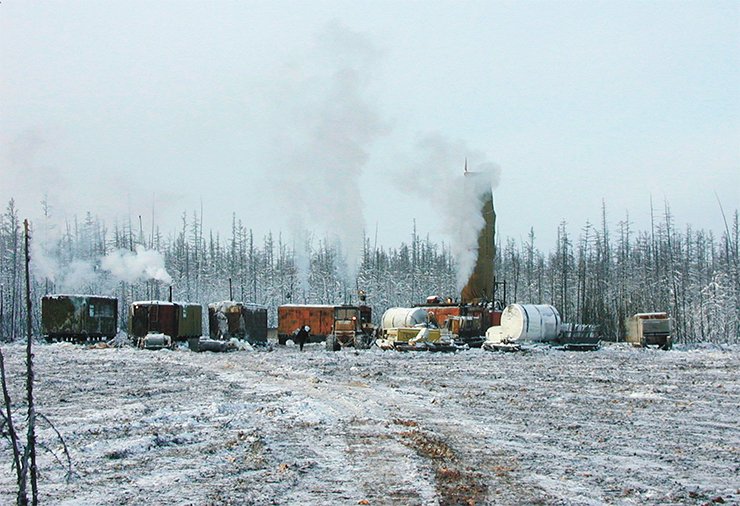
With the discovery of Tomtor, the strategy of prospecting work changed. At first, it was directed to outlining linear zones of rare-metal mineralization. Then it was confined to the massif itself, because it was natural to suggest that Tomtor formation had generated phosphate and rare-metal mineralization (Erlikh, 2006).
The development of the main geological notions of Tomtor formation is presented in my article in Zvezda magazine (2006).
The core of the massif
Central and western areas of Tomtor are covered by sedimentary rocks. Elucidation of their structure demanded geophysical studies. They were started with aeromagnetic survey at 1 : 50,000 scale by researchers of the Institute of Arctic Geology headed by A.M. Karasik. It showed that magnetic anomalies formed a series of concentric arcs, and their high intensity indicated that they were associated with bodies of pure magnetite. According to the gravimetrical studies done by geophysicists of the Amakinsky expedition, the core of the massif was built by an association of light and unmagnetic rocks. The reasonable and uncontroversial conclusion was that the Tomtor core was built by carbonatites. This hypothesis presumed that we encountered an enormous carbonatite body, whose diameter exceeded those of the largest carbonatite massifs of the world by an order of magnitude.
Stepanov (2002) recollected that the situation was incomprehensible in 1973; the team was in a fever, not knowing what to do or what hypothesis should be taken for further exploration. Had it been true, I should have been fired for the inaptitude to the position. I was sure of the carbonatite nature of the core.
The first achievement of drilling was the detection of dike-like bodies built by massive magnetites. We found an iron ore deposit similar to famous Swedish Kiruna. This modest deposit, located in Arctica, was of no significance by itself, but it answered the question of the composition of the Tomtor core. In my opinion, core fragments formed by carbonate–magnetite aggregates with mica and apatite were the most important finding. They consisted of a mineral assemblage characteristic of rocks associated with carbonatites, so-called phoscorites. They accompanied jacupirangite dikes. The composition of these veinlets also supported the expectance of carbonatites in central Tomtor.
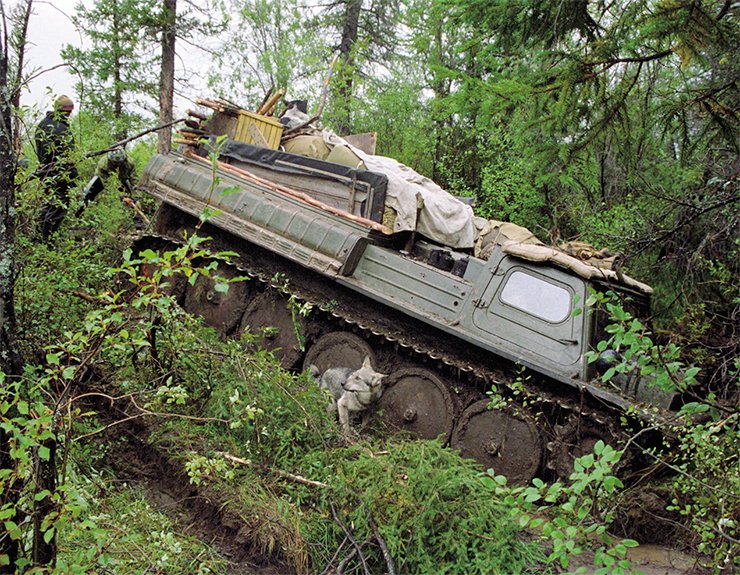
In the next year, drilling was conducted within the carbonatite core. Ore presence was certain. Carbonatites are always associated with large rare earth deposits. The situation in the team at that time was precisely described by Stepanov, who recited the recollection of our drilling manager P.I. Romashko that I had told him about cities to arise there, in Tomtor, in the footsteps of our drilling. Just at that time, I had a stroke, and I was brought to hospital by an ambulance flight. The disease knocked me out of action, but I wrote the report and delivered it himself. The work was done.
How mine fields are discovered
The history of Tomtor discovery, if open-mindedly approached, is instructive. It is polar to the history of the discovery of diamond fields in Siberia. The difference concerns the way the main problem of search for any mineral resources is solved: What rock body types are resources in question associated with? By the start of work in Siberia, this problem had been solved by South African geologists. What should be done in Russia was to transfer the ideas to the local ground. However, even after A.A. Kukharenko’s establishment of the identity of pyropes found in Siberia and African standard samples donated to him, diamonds were sought following the model of diamond field relationship to igneous rock associations of the Uralian type. Fainschtein believed that the word kimberlite was an invention of cosmopolitans (TN: Cosmopolitan, or rootless cosmopolitan was a Soviet derogatory epithet widely used during Joseph Stalin’s anti-Semitic campaign of 1948–1953 and somewhat later.)
The key point in Tomtor exploration was to admit the obvious facts we encountered. Here I try to describe our difficult way in defending the ideas that would lead to the discovery of the ore field.
It should be noted that the way to the discovery of the carbonatite Tomtor core was the same as in the discovery of Talnakh and the Mir pipe (Erlikh, 2013): by means of stepping over missing facts, the trial-and-error method, and constant correction of the working hypothesis.
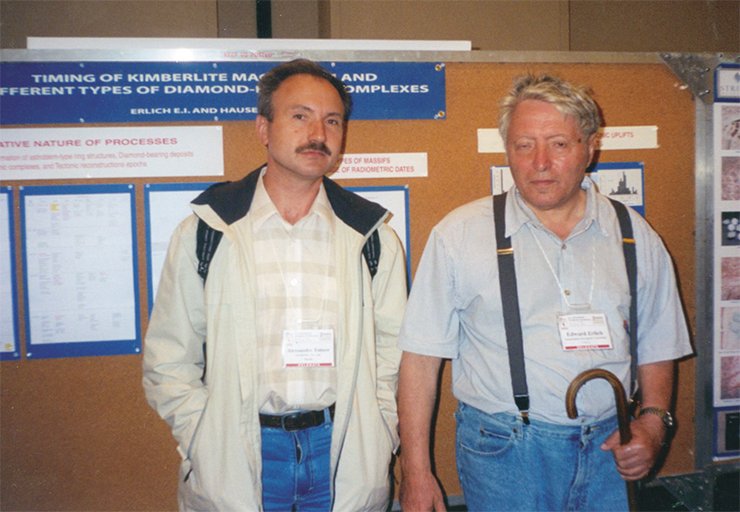
As described by L. Stepanov (2002), the work of the team was specialized: drivers drove their vehicles, drillers drilled, and geophysicists took measurements. But mine fields cannot be discovered by merely bulking primitive actions. A quantum leap is always needed to construct an ore formation model. Lacking facts should be stepped over. What is important, somebody must take on the liability for the hypothesis and put his professional reputation on the line.
I was that man in the case of the Tomtor carbonatite core. I reported the reasons and conclusions arguing for the hypothesis of Tomtor structure to the then Chief Geologist of Amakinka E. Chernyi and applied for prolonging the work for one year. He did us the service, and the extra year was decisive.
The history of the discovery of overabundant ores in Burannyi was opposite. In that case, the theoretical road had been paved. An illustrative description of the discovery was done by A. Tolstov. The process reminded adjustment gunfire. The grid of boreholes was intensified, and the area of overabundant ores was delineated.
Proper respect should be given to Tolstov. Judging from his notes, he always thought of the significance of the deposit, in particular, how to relief rare metal import. Starting from 1986, he appeared at various conferences with reports on niobium and rare earths of the lanthanum–cerium group and stubbornly insisted on the enormous significance of the giant ore deposit in the face of researchers and public.
References
Belousov V. I. Vulkanizm, gidrotermal’nyj process i rudoobrazovanie // https://sites.google.com/site/geyzeruzon/kaldera-uzona/--istoria-issledovania / nauch. red. E. N. Еrliсh.
Egorov L. C., Surina L. P., Porshnev G. I. Udzhinskij rudno-magmaticheskij kompleks ul’traosnovnyh-shhelochnyh porod i karbonatitov // Rudno-magmaticheskie kompleksy s-z Sibirskoj platformy i Tajmyra. (gorod): M.: Mingeo SSSR, PGO «Sevmorgeologija», 1985. S.138—154.
Еrliсh E. N., Belousov V. I. Geologo-petrologicheskie problemy geotermii // https://sites.google.com/site/geobelousov/geotermia.
Еrliсh E. N. Legendy Tomtora (k istorii otkrytija). Byli i bajki NIIGA-VNIIOkeangeologija (1948-2008). SPb.:Izd. VNIIOkeangeologija, 2012. S. 394—400.
Erlich E. N. Najti mestorozhdenie // Zvezda. 2006. № 12
Erlich E. N. Mestorozhdenija i Istorija // https://sites.google.com/site/vulkaniceskaageologia/home/mestorozdenia-i-istoria, 2013.
Erlich E. N. Novaja provincija shhelochnyh porod na severovostoke Sibirskoj platformy // Zapiski VMO. 1964. T. 93, № 6. S. 682—693.
Erlich E. N.Ocherki geologii ostrovnyh dug // https://sites.google.com/site/vulkaniceskaageologia/home/ocerki-ostrovnyh-dug.
Kravchenko S. M., Beljakov A. Ju. Novichok sredi gigantov // Priroda. 1992. № 4. S. 50—55.
NIIGA – VNIIOkeangeologija 50 let nauchnogo poiska. SPb.: VNIIOkeangeologija, 1998. 127 s.
Porshnev G. N., Stepanov L. L. Geologicheskoe stroenie i fosfatonosnost’ massiva Tomtor // Shhelochnoj magmatizm i apatitonosnost’ severa Sibiri. L.: Nedra, 1980. S. 84—101.
Stepanov L. L. Poljarniki pishut sami (jubilejnye vospominanija, posvjashhennye 40-letiju PMGRJe). SPb., 2002.


